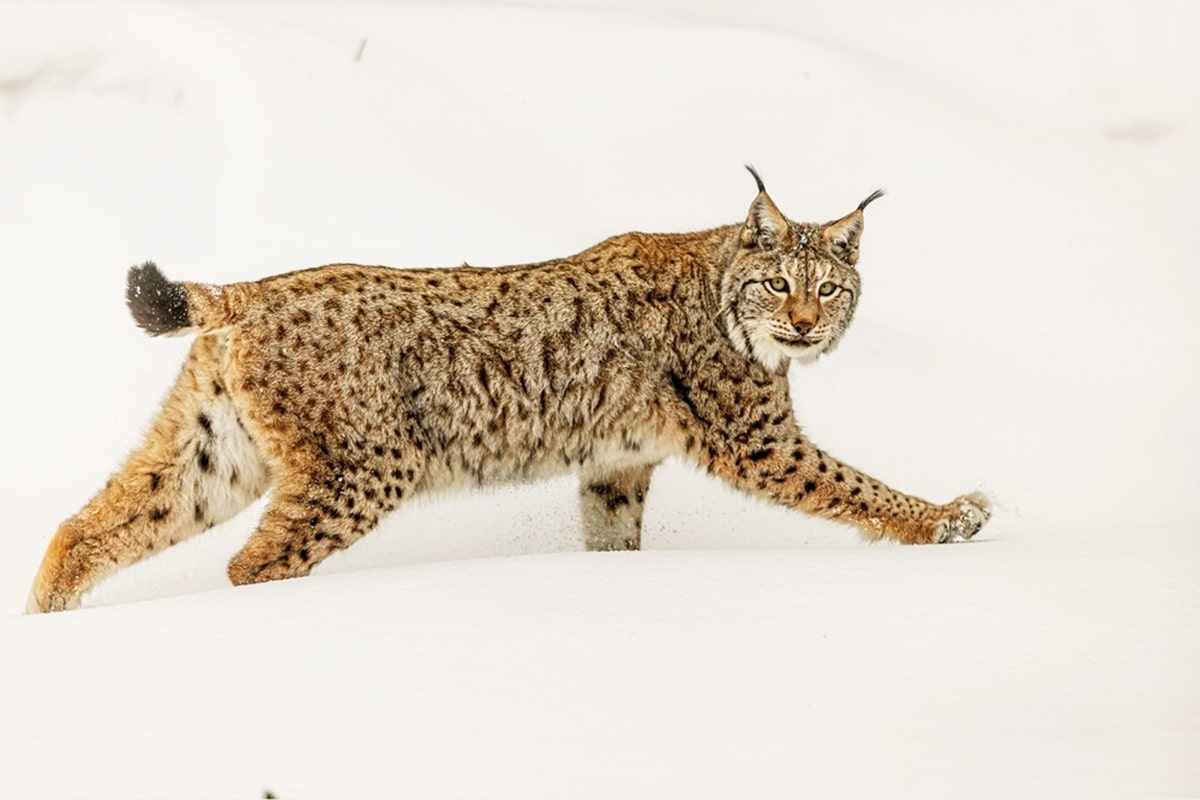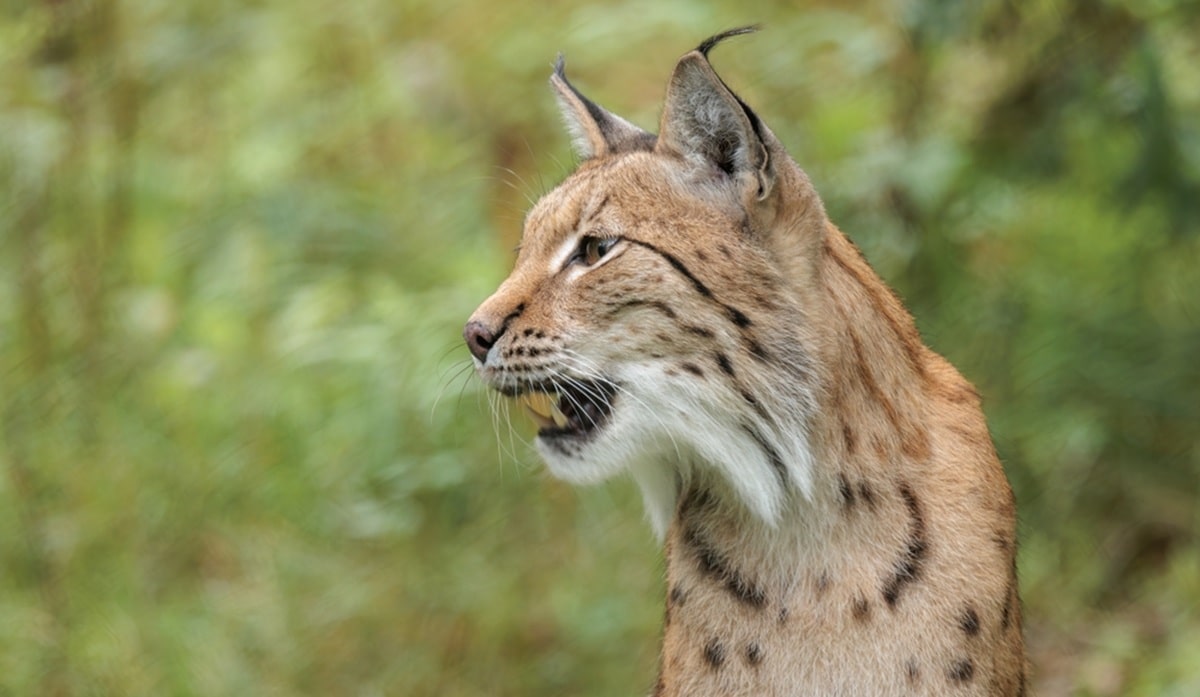
While the idea of lynx prowling British woodlands sounds fanciful, across Europe the Eurasian lynx is flourishing in places where it had once disappeared. This has only happened following decades of recovery work, and it’s led conservationists to ask whether lynx could be brought back here, too.
We find out why this shy, bob-tailed wild cat vanished from Britain, the science behind proposed reintroductions and the likely impacts, along with the views of supporters and opponents.
When were lynx last in Great Britain?
Eurasian lynx survived in southern Scotland until becoming extinct hundreds of years ago, around 1300. Bones and cultural references show the species was present here until at least early medieval times; some evidence suggests that lynx survived in parts of Britain into the Middle Ages. Over centuries, the species declined and became extinct due to hunting and habitat loss as wild land was converted to farmland. By the end of the medieval period, the lynx was effectively extinct in Britain.
On the continent the story was similar: lynx populations were reduced years ago but, unlike in Britain, in many regions they remained in small numbers and later benefited from legal protection, reduced persecution and active reintroductions. Today, Eurasian lynx are making a recovery in parts of central Europe due to conservation efforts. There are healthy populations in Scandinavia, the Carpathians, the Alps and they have been reintroduced in Switzerland, Slovenia and Germany. Populations are recovering in Sweden, Norway, Finland and eastern Europe.

Why bring them back? The conservation case
Natural deer control prevents overgrazing
Top predators like lynx play an important role in the ecosystem; through scent marking, they advertise their presence and change the behaviour of other species. Keeping animals on the move allows young trees and vegetation to grow and prevents overgrazing.
Lynx prey primarily on medium-sized deer, particularly roe deer. Where lynx have recolonised parts of Europe, research has shown reductions in deer numbers or changes in deer behaviour and density which can relieve browsing pressure on young trees. Studies from continental Europe suggest lynx can help restore more natural forest structure and biodiversity.
A 2015 British Deer Society commissioned report stated that for any reintroduction to happen, a non-native species licence would be required from Natural England, Scottish Natural Heritage or Natural Resources Wales. The application would have to demonstrate evidence including environmental impacts, plus public consultation.
Ecosystem recovery
By re-establishing a formerly native predator, proponents say woodlands and associated habitats can recover processes lost when top predators disappeared centuries ago. This style of environmental management is part of the broader rewilding rationale in place across Europe.
Nature and people
Reintroducing lynx can bring tourism and educational opportunities and provide a powerful symbol that countries are working to reverse biodiversity loss.

Where could lynx live in Britain?
Rewilding groups and feasibility studies have identified forested areas of Britain with low human density as the most suitable, particularly 250 square mile Kielder Forest, England’s largest forest, other large northern forests, parts of the Cairngorms National Park, some Highland landscapes, and remote wooded areas in Cumbria and Kintyre.
These landscapes offer extensive woodland, a good prey base (roe and other deer), and relatively low livestock density; features associated with successful lynx populations elsewhere. Lynx trial site selection suggests a small number of well-chosen release sites could support a viable population of this keystone species.

Who’s supporting lynx reintroduction and who’s opposing it?
Supporters of reintroducing species
Rewilding charities such as Rewilding Britain, Trees for Life, the Missing Lynx Project and the Lynx UK Trust lead much of the campaigning and feasibility work. The Missing Lynx project argues that the lynx is the best candidate for reinstating a large predator in Britain because they are secretive, feed mainly on deer, and have a well-documented track record of recovery when protected and, where needed, reintroduced. The Lynx UK Trust has prepared formal proposals for trial releases and has run site assessments and public consultations in previous years.
Statutory voices
Natural England’s chair Tony Juniper has spoken favourably about lynx reintroduction, emphasising that schemes must be science-led and acceptable to local communities. Central government ministers and departments have been cautious; in 2018 a high-profile application for a trial release at Kielder was refused, partly because ministers judged local “buy-in” to be insufficient and legal hurdles (for example the Dangerous Wild Animals Act and licensing) had not been resolved.
Opponents
Farming organisations, notably the National Farmers’ Union (NFU) and NFU Scotland, are strongly opposed. Their objections focus on livestock welfare and the risk of sheep predation, the practicalities of compensation schemes, and the view that rural communities would bear the costs while benefits from, for example tourism, would accrue elsewhere. The NFU has stated that predator reintroductions like lynx are “wholly unacceptable” and has lobbied ministers to reject proposals.
Public sentiment is mixed and varies locally: recent surveys and stakeholder studies show farmers and land managers are more negative, while urban and many non-farming rural residents are often more positive. That division has made formal approval politically sensitive. As the British Ecological Society clarified in a 2023 research article, the socio-cultural considerations should be given equal weighting with ecological and biological aspects of a project.

What does the science say about likely impacts?
Academic and technical studies form the backbone of feasibility assessments. Peer-reviewed modelling and empirical work from Europe and hypothetical UK scenarios indicate:
Deer reduction is plausible but variable
Where lynx are present, roe deer densities commonly fall or redistribute, depending on habitat, prey availability and lynx density; some studies show pronounced local reductions, others more subtle behavioural changes in deer. The British Deer Society notes that translating continental results to Britain requires careful local modelling.
Low risk to local people
Eurasian lynx rarely attack people; evidence from Europe shows they are shy and avoid humans. According to Rewilding Europe, the principal conflicts are with livestock, primarily sheep and young deer, rather than public safety.
Management and mitigation work
Successful reintroduction projects elsewhere have involved compensation measures, livestock protection measures such as guardian dogs, overnight corralling and rapid response teams to deal with incidents. The Guardian noted a recent UK study modelling Kielder which found that releasing as few as 20 lynx could potentially establish a sustainable core population of around 50 animals. The study emphasised the importance of local acceptance and legal frameworks.

Real-world experience: where lynx thrive now
Reintroduced or recovering lynx species and populations in other countries across mainland Europe offer instructive examples:
Scandinavia, Sweden and Finland
Thousands of lynx exist in these European countries, alongside regulated hunting and compensation schemes for livestock losses. Ambitious reintroduction projects have led to lynx becoming a common sight: populations are monitored and are stable or increasing.
Central Europe
Germany successfully reintroduced lynx to the Harz National Park and Bavarian forests and they also have a home range in the Alps. The species is understood to have delivered ecosystem benefits, forest regeneration and enabled wildlife tourism.
Spain and Portugal
Captive breeding and release programmes have increased numbers of the Iberian lynx from fewer than 100 in the early 2000s to over 2,000 today, according to The Guardian.
These success stories show lynx can recover when protected in a project region, monitored and managed alongside prey populations and people. However, they also underline the need for collaboratively designed and site-specific planning.

What are the main risks and legal hurdles with lynx reintroduction?
Legal/regulatory
Trial releases must comply with The Dangerous Wild Animals Act and licensing laws. Reintroducing lynx would require clear legal pathways and ministerial approval.
Social feasibility and acceptance
Without sustained engagement, workable mitigation (compensation, livestock protection) and measures to reduce risks, reintroductions risk inflaming rural-urban divisions and creating long-term conflict. According to a British Ecological Society journal, studies repeatedly show social acceptance is as important as ecological suitability.
Rogue releases
Lynx have been illegally released into the wild, which has complicated the science-led approach to releases and damaged public trust.
Could lynx return to Britain?
The answer appears to be yes, in the right areas with appropriate management in place. European examples suggest that these large carnivores can establish in suitable areas, reduce some deer impacts and reinstate biodiversity. However, the social, legal and political barriers are substantial: farmers’ concerns about sheep predation, legal constraints, the need for compensation and mitigation schemes, and the risk that unauthorised releases could derail projects remain.
The critical part of the question is not only whether the habitat is right, but whether people living and working in the selected landscapes are willing to share them with a predator that’s been absent for centuries.
If communities can be engaged, compensation and protection mechanisms put in place, and monitoring and rapid-response systems funded, lynx reintroduction could be one of the bolder steps taken to repair Britain’s damaged ecosystems. If not, the idea is likely to remain a contested `what if’ conservation debate.
Eurasian Lynx – facts and figures
- Weight: approximately 18kg.
- Length: approximately 1m.
- Height: approximately 0.75m.
- Speed: 69km/hour.
- Litter size: typically, 2-3 cubs.
- Ideal habitat: forest and rocky areas providing cover to hunt prey from.
- Population across Europe, Siberia and central Asia: 50,000 (9,000 in Europe.)
- Food source: roe deer and larger species such as red deer, along with foxes and rabbits.



